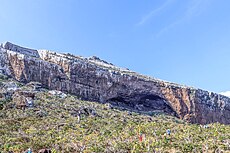Category:Hoq Cave
cave of the island of Socotra (Yemen) | |||||
| Upload media | |||||
| Instance of | |||||
|---|---|---|---|---|---|
| Location | Hidaybu (Socotra-East) District, Socotra Governorate, Yemen | ||||
 | |||||
| |||||
The Hoq cave is one of the most important archaeological sites in the Arabian Sea, near the mouth of Red Sea, on the island of Socotra (Yemen). The island is about 400 kilometers south of Arabian peninsula, 320 kilometers from the African coast and 2000 kilometers from the Indian peninsula. It is so far from the African and Asian mainland that, like Madagascar, it has a highly endemic flora and fauna. The Hoq cave is close to the eastern coast of the Socotra island. It is about 2 kilometer long cave about 1200 feet above sea level, with an arid interior that is naturally air conditioned year round. The Hoq cave became a scientific sensation when Russian archaeologists discovered inscriptions inside the cave in late 20th-century, then these inscriptions were verified, photographed and published by numerous other scholars in 2000s and 2010s.
The Hoq cave has 216 inscriptions in different scripts and languages. Each inscription is short but important because they are from 1st to 6th century CE, and they attest to seafaring trade between Europe, Africa, Middle East and India. They thus corroborate the controversial records and manuscripts from ancient Greece, Roman, Ethiopia, Egypt, Persia and India which mention ports and trading networks, but which are inconsistent and some whose credibility is questionable.
Of the 216 inscriptions found in Al Hoq cave,193 are in Sanskrit and hybrid Sanskrit (predominantly Brahmi script). The cave also has 11 South Arabian inscriptions, 8 Aksumite, 3 Greek and 1 Aramaic inscription. There are no Christian and no Islamic inscriptions in Al Hoq cave. Among the Indian inscriptions are Hindu and some are Buddhist. According to Indologist Strauch, "“the corpus of Indian inscriptions at Hoq is a unique witness for early Indian history and culture. It offers a glimpse into a sphere of Indian society which is otherwise not accessible to us”.
For more details about Al Hoq cave and Socotra island, as well as photographs and translations of many of these inscriptions inside the cave, see Ingo Strauch (2012), Lausanne University, Foreign Sailors on Socotra, Bremen:Hempen Verlag.
Media in category "Hoq Cave"
The following 16 files are in this category, out of 16 total.
-
Al Hoq Cave with Brahmi Greek Aramaic and other inscriptions, Socotra Yemen 01.jpg 5,472 × 3,648; 20.52 MB
-
Al Hoq Cave with Brahmi Greek Aramaic and other inscriptions, Socotra Yemen 02.jpg 5,407 × 3,605; 16.61 MB
-
Arher dunes and Hoq cave (6408216391).jpg 1,908 × 1,272; 645 KB
-
Cave Flight, Socotra Island (10943692103).jpg 4,016 × 6,016; 843 KB
-
Hoq Cave - entrance.jpg 1,024 × 683; 231 KB
-
Hoq Cave - speleothem1.jpg 1,024 × 683; 186 KB
-
Hoq Cave - speleothem2.jpg 683 × 1,024; 212 KB
-
Hoq Cave Speleothem, Socotra Island.jpg 1,600 × 1,067; 212 KB
-
Hoq Cave, Socotra Island (50934614243).jpg 3,780 × 5,670; 664 KB
-
Socotra Cave 00.JPG 3,264 × 2,448; 1.76 MB
-
Socotra Cave 01.JPG 3,264 × 2,448; 885 KB
-
Socotra Cave 02.JPG 3,264 × 2,448; 1.97 MB
-
Socotra Cave 03.JPG 3,264 × 2,448; 1.43 MB
-
Socotra Cave 04.JPG 3,264 × 2,448; 1.92 MB
-
Socotra Cave 05.JPG 3,264 × 2,448; 1.98 MB
-
Socotra Cave 06.JPG 3,264 × 2,448; 1.56 MB

















